
New resources for East Asian Buddhist Studies at DDBC
![]() Dharma Drum Buddhist College is developing a number of projects in digital textual studies, all making use of TEI. The simultaneous presentation of digitized text with corresponding data, whether it be a scanned image of the original or something else, is one of the technologies being pioneered. When coupled with markup that allows for automatic search and indexing, the benefits are plain to see.
Dharma Drum Buddhist College is developing a number of projects in digital textual studies, all making use of TEI. The simultaneous presentation of digitized text with corresponding data, whether it be a scanned image of the original or something else, is one of the technologies being pioneered. When coupled with markup that allows for automatic search and indexing, the benefits are plain to see.
Here’s an example (but first note that the following unnanounced items are to some extent experimental):
Archive of Buddhist Temple Gazetteers (中國佛寺志): http://dev.ddbc.edu.tw/fosizhi/ui.html
A similar project is a fledgling concordance of published translations, both English and German, with the Chinese source material. Apart from what is there now, which is already an achievement in itself, with a little imagination, one can see where they are going with this. And it is an interesting place:
Archive of Translations from the Buddhist Canon: http://dev.ddbc.edu.tw/han2e/ui.html*
Dharma Drum are also creating or digitizing specialized glossaries for Buddhist studies. Currently they have three available in Unicode, either in XML (from which almost any format could be generated) or StarDict format:
- Soothill-Hodous (1937)
- Mahāvyutpatti
- Wuyi hebi jiyao 五譯合璧集要 [Manchu-Chinese-Sanskrit]
These guys are doing pioneering work; the digital material they present is entirely legal; they strive, “as a matter of principle, to support Open Software and Open Standards.” I have no hesitation about mentioning them here. (Thanks to 馬 德偉 for the tip.)
* Translations digitized and collated so far:
- T 2085: A Record Of Buddhistic Kingdoms 高僧法顯傳
- T 2125: A record of buddhist religion as practised in India and the Malay Archipelago 南海寄歸內法傳
- T 1573: The Ekashloka Shastra 壹輸盧迦論
- T 1576: NĀGĀRJUNA’S MAHĀYĀNA-VIṀSAKA 大乘二十頌論
- T 1569: THE ŚATAŚĀSTRA 百論
- T 1667: Açvaghosha’s Discourse on the Awakening of Faith in the Mahâyâna 大乘起信論
- T 1666: The Awakening of Faith 大乘起信論
- T 1620: The Hand Treatise:A work of Āryadeva 解捲論
- X 671: The Sutra in Forty-Two Sections 四十二章經
- T 2087: Datang xiyu ji [Beal] 大唐西域記
- T 450 The Sutra of the Lord of Healing 藥師經
- T 2049 The Life Of Vasubandhu 婆藪槃豆法師傳
- T 366 The Smaller Sukhāvatī-vyūha 佛說阿彌陀經
- T 1590: Wei shih er shih lun 唯識二十論
- T 365: Amitâyur-Dhyâna-Sûtra. The Sûtra of the Meditation on Amitâyus 佛說觀無量壽佛經
- T 317: Buddha spricht über Embryologie 佛說胞胎經
- T 475: Vimalakirti’s discourse on emancipation 維摩詰所說經
The Theravādin who extolled King George’s Aṣṭaka
 In religions of hearsay and repetition, there is so little internal variety that we must look to the fringes for anything interesting. And from the early nineteenth century, when Ceylon first experienced the jolt of British colonial rule, we have such a case: the Sinhalese monk Śrīdharmārāma’s eight verses in praise of his new sovereign, King George III — in Sanskrit.
In religions of hearsay and repetition, there is so little internal variety that we must look to the fringes for anything interesting. And from the early nineteenth century, when Ceylon first experienced the jolt of British colonial rule, we have such a case: the Sinhalese monk Śrīdharmārāma’s eight verses in praise of his new sovereign, King George III — in Sanskrit.
It was a remarkable first move from a community which, in years to come, would be rather less willing to associate with all things Sanskritic, British, and non-Theravādin. As an opening cross-cultural gambit, the Jorjjirājāṣṭaka tells us a little about how the Hīnayāna attempts a discourse of universality. There is the striking use of a lingua franca, Sanskrit, to address a foreign monarch. Pali is out of the question, although the poet cannot completely exclude it from his thinking (cf. 5c).
What is especially remarkable is that not even a trace of Buddhism seeped into this overture to a distant power. Śrīdharmārāma no doubt expected that his ruler fit the standard South Asian mould, and would approve of the stock comparisons with mighty Hindu deities (8a–c). His praise is therefore generic, on the whole. But from the point of view of mainstream Buddhism, there was a serious opportunity lost, not to mention a failure of imagination, in neglecting to allude to even some notion of salvific saddharma.
Below is a draft e-text of the Jorjjirājāṣṭaka itself. It is flawed; having made several dozen corrections already, I ran out of both time and interest. Many readers will, no doubt, be able to improve it further. Perhaps, also, it is just not that well written. As the text’s publisher, Dehigaspe Pannasara, observes, with regard to Śrīdharmārāma’s times: “The study of Sanskrit and other languages suffered a great setback” … “Owing to the state of unrest and anarchy… the Dutch were harassing the country” (p.188). Maybe that had something to do with it; maybe the systematic destruction of Sanskrit works by Theravādins in thirteenth-century Laṅka (already mentioned on p.17–18) had something to do with it, too.
So, without further ado, here is the e-text, posted in celebration of the final weeks of overlordship of our own King George: incompetent, warmongering, theist empire-builder.
[E-TEXT UNDER REVISION]
CATALOGUE OF TIBETAN TEXT
Probably not coming to a library near you:

Bhim Prasad Nepal (Chief Editor), Jagannath Upadhyaya (Editor), Punya Prasad Parajuli and Mohan Singh Lama (Cataloguer). བོད་ཡིག་དཀར་ཆག་ Catalogue of Handwritten Tibetan Texts Volume–1. Archives Publication Series 10. Ramshah Path, Kathmandu: National Archives, VS 2064 Ashad [July 2007]. 192 pp.
Bhim Prasad Nepal (Chief Editor), Jagannath Upadhyaya (Editor), Punya Prasad Parajuli and Mohan Singh Lama (Cataloguer). བོད་ཡིག་དཀར་ཆག་ Catalogue of Handwritten Tibetan Texts Volume–2. Archives Publication Series 11. Ramshah Path, Kathmandu: National Archives, VS 2065 Baishakha [May 2008]. 283 pp.
 Arranged in alphabetical order. Most of the MSS catalogued are affiliated with the rNying ma pa. Much of the value here lies in the mystifying one-line summaries (“Content in English”).
Arranged in alphabetical order. Most of the MSS catalogued are affiliated with the rNying ma pa. Much of the value here lies in the mystifying one-line summaries (“Content in English”).
Kintner's footage of Nepal, 1957 CE
The home movies of Watson Kintner (1890–1979), shot on 16mm film over several decades, were archived at the University of Pennsylvania Museum, and have now made their way to archive.org. Kintner’s engineering-related globetrotting brought him to Nepal just a few years after its doors opened to the outside world. It was a place which had barely changed since Lévi, Sāṅkṛtyāyana and Tucci first set foot there earlier in the 20th century (Tucci continued to visit throughout the 1950s); and which even then was much as Hodgson, Oldfield and Bendall had known it. When these films were taken, Nepal was still relatively isolated, and had only recently begun to build an electricity and telecommunications infrastructure. David Snellgrove — who also shot movies during his visit (archived at the Institute for Buddhist Studies, Tring) — wrote in his book, published in the same year, that key trade routes in Nepal would “never” be resurfaced as “motorable roads”. (A few years later, they were.)
Kintner’s footage is remarkably evocative in spite of its amateur quality, capturing moments in the life of Newar Buddhism as it existed prior to the onslaught of modernity, missionaries and anthropology. Much has changed; nonetheless, those who know the terrain will see much that has not, and which is recognizable even now. In the list below, I’ve added preliminary notes on locations, events and so on, to help orient potential viewers:
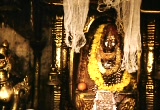 1: Tibetan pilgrims at Bodhnāth (00:00); Chvaskāminī shrine (09:52); thangkas [with sub-legible inscriptions] (14:30); Svayambhū (15:33).
1: Tibetan pilgrims at Bodhnāth (00:00); Chvaskāminī shrine (09:52); thangkas [with sub-legible inscriptions] (14:30); Svayambhū (15:33).
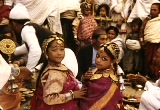 2: Hāritī pūjā, Svayambhū (00:00); cremation (02:13); Mheipī [??] (05:19); abhiṣeka of newly ordained monk (08:51) and simultaneous jñānāhuti homa (09:30); curtain (dagiṃ) over portal to tantric shrine; non-Buddhist īhi [mock marriage], Bhaktapur (13:50).
2: Hāritī pūjā, Svayambhū (00:00); cremation (02:13); Mheipī [??] (05:19); abhiṣeka of newly ordained monk (08:51) and simultaneous jñānāhuti homa (09:30); curtain (dagiṃ) over portal to tantric shrine; non-Buddhist īhi [mock marriage], Bhaktapur (13:50).
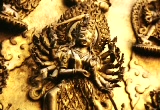 5: Southern Stupa, Lalitpur (16:08).
5: Southern Stupa, Lalitpur (16:08).
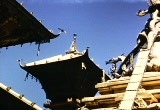 6: Kwā Bahā (00:38); Oku Bahā (02:23); Śaiva pilgrims (16:34).
6: Kwā Bahā (00:38); Oku Bahā (02:23); Śaiva pilgrims (16:34).
 17: Jana Bahā (02:28); Oku Bahā (02:23); Hanumān Ḍhokā (04:30); Śrīghaḥ (06:30); Paśupati (13:37).
17: Jana Bahā (02:28); Oku Bahā (02:23); Hanumān Ḍhokā (04:30); Śrīghaḥ (06:30); Paśupati (13:37).
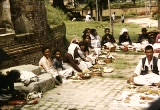 18: Buddhist vrata, Lalitpur (00:36); Mahābuddha (02:48); Oku Bahā’s Tibetan shrine (gumba) [now almost defunct] (04:38); Prajñāpāramitā recitation, Kwā Bahā (06:06); Svayambhū caitya (09:00, 16:35); worship of dharmadhātu (13:20).
18: Buddhist vrata, Lalitpur (00:36); Mahābuddha (02:48); Oku Bahā’s Tibetan shrine (gumba) [now almost defunct] (04:38); Prajñāpāramitā recitation, Kwā Bahā (06:06); Svayambhū caitya (09:00, 16:35); worship of dharmadhātu (13:20).
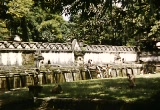 20: Balaju [back when it had running water] (03:48) ; Bodhnāth stupa, from the adjacent fields (15:45).
20: Balaju [back when it had running water] (03:48) ; Bodhnāth stupa, from the adjacent fields (15:45).
Also: 7 (Paśupati & Darjeeling); 8 (Kalimpong); 19 (Bhaktapur, with masked “devī” dancers).
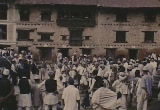 Bonus: “Dr. Harry B. Wright’s Nepal Travelogue”: shamans (jhaṅkri) (10:10); Matayā [?] (19:50); lākhe dancers (28:41); Tibetan dancers, Bodhnāth (30:27).
Bonus: “Dr. Harry B. Wright’s Nepal Travelogue”: shamans (jhaṅkri) (10:10); Matayā [?] (19:50); lākhe dancers (28:41); Tibetan dancers, Bodhnāth (30:27).
Manuscript Digitization in Munich

The Bavarian State Library (Bayerische Staatsbibliothek, München) has been gradually digitizing its collections of manuscripts, including its non-European collections (PDF). The manuscript cover shown above, an extraordinary example of tantric Buddhist art, goes with MS BSB Cod.tibet.923; other images of the manuscript are found here. So far they have digitized one other Tibetan (=Mongolian) MS: BSB Cod.tibet.894. Looking forward to seeing their Nepalese and Balinese Buddhist collections come online.
Nuggets of Untruth (II): On being called a Professor
A Correction: Contrary to a remark made in Greg Seton’s recent post on H-Buddhism (Nov. 22, 2008), I am not, at present, a Professor. Nor am I a PhD; nor have I ever claimed to be either.
This remark put me in an awkward position. One could post a correction to the list; but that would do more than merely add to the level of noise. It would also be to affirm a lowly status in the eyes of those who think that advanced degrees mean everything. Now that outcome, in itself, shouldn’t bother anyone in the slightest. Unfortunately, however, it does lead to difficulties, in my experience; for example in acquiring the all-important, yet notoriously elusive, primary materials for the study of Indo-Newar Buddhism. (For an example of what I’m talking about, note the desperate and isolated tone of Mr. Seton’s plea for manuscripts; and this guy is at Oxford, home to some of the most precious Sanskrit Buddhist manuscripts on the planet!)
The alternative is to say nothing. But this could be seen as deliberately failing to stop the dissemination of a falsehood. On the other hand, I hope you can understand why I may be reluctant to further associate myself with a thread that is plainly rife with errors and infelicities (which provided the spur for my emailing its author in the first place).
So, my solution for now will be to post a correction here, where it will be on the record, for anyone who wants to look for it, while being kept out of the face of the put-upon readers of H-Buddhism.
[And if you have made it this far, dear reader, I will let you in on something: this blog was actually started in response to dissatisfaction experienced in dealing with H-Buddhism; and it was resurrected earlier this year — something I was quite unwilling to do — for the very same reason. May the internet always grant us some mechanism(s) for circumventing the gatekeepers of official truth.]
Bühnemann / Buddhist Iconography and Ritual in Paintings & Line Drawings from Nepal
![]() Gudrun Bühnemann. Buddhist Iconography and Ritual in Paintings and Line Drawings from Nepal. Lumbini: Lumbini International Research Institute, November 2008.* ISBN 978-99946-933-4-4. [Now available through Vajra Books.]
Gudrun Bühnemann. Buddhist Iconography and Ritual in Paintings and Line Drawings from Nepal. Lumbini: Lumbini International Research Institute, November 2008.* ISBN 978-99946-933-4-4. [Now available through Vajra Books.]
Contents:
Preface … 7
1. Pictorial Representations of a Tradition of Eighty-Four Siddhas … 9
1.1 Early Textual Sources: *Śrīsena and Bu ston … 9
1.2 A Painting from Bhaktapur Portraying the Siddhas around Vajradhāra … 16
1.2.1 A Discussion of the Painting … 16
1.2.2 A Reproduction of the Painting … 21
1.3 An Incomplete Set of Line Drawings from LACMA Portraying the Siddhas … 25![]()
1.3.1 General Remarks on the Line Drawings … 25
1.3.2 A Reproduction of the Line Drawings … 29
1.4 A Painting from the Kronos Collections Portraying the Siddhas around Virūpā … 45
1.4.1 A Discussion of the Painting … 45
1.4.2 A Reproduction of the Painting … 51
1.5 The Siddha Tradition according to the Two Paintings and the Line Drawings … 55
1.5.1 The Names of the Siddhas in the Bhaktapur Painting and the Line Drawings … 55
1.5.2 The Representation of the Siddhas in the Two Paintings and the Line Drawings … 58
2. Pictoral Representations of Sixty-four and Thirty-six Forms of Cakrasaṃvara … 97
2.1 The Sixty-four Saṃvaras … 97
2.1.1 The Painted Scroll in the Dabriwala Collection Depicting the Sixty-Four Saṃvaras … 97
2.1.1.1 Remarks on the Painted Scroll … 97
2.1.1.2 A Reproduction of the Painted Scroll … 1052.1.2 The Saṃvaras according to the Catuḥṣaṣṭisaṃvarastotra … 115
2.1.2.1 The Saṃvaras Eulogized in the Catuḥṣaṣṭisaṃvarastotra … 115
2.1.2.2 The Illustrated Stotra Manuscript in the Huntington Collection … 118
2.1.2.3 The Illustrated Stotra Manuscript in the Alsop Collection … 123
2.2 The Thirty-Six Saṃvaras
2.2.1 The Thirty-six Saṃvaras Eulogized in the Chatrisaṃvarastuti … 123
2.2.2 Line Drawings Likely Depicting Another Group of Thirty-Six Saṃvaras … 1262.2.2.1 Remarks on the Line Drawings … 126
2.2.2.2 A Reproduction of the Line Drawings … 131
3. A Set of Line Drawings Based on the Parikramavidhi in Kuladatta’s Kriyāsaṃgraha(pañjikā)
3.1 Introductory Remarks … 153
3.2 The Kriyāsaṃgraha(pañjikā) … 154
3.3 The Author Kuladatta … 157
3.4 The Parikramavidhi in Chapter 6 of the Kriyāsaṃgraha(pañjikā) … 1593.4.1 Introductory Remarks on the Parikramavidhi … 159
3.4.2 Extant Sets of Line Drawings Based on a Section of the Parikramavidhi … 164
3.4.3 A Set of Line Drawings from the Los Angeles County Museum of Art 1673.4.3.1 A Preliminary Analysis of the Set of Line Drawings … 167
3.4.3.2 A Reproduction of the Set of Line Drawings L … 177
Selected Bibliography and Abbreviations … 197
General Index … 207
* Thanks to the author for acknowledging yours truly (Preface, p.[7]).
Kaiser lib. Centenary stamp

Now all we need is the commemorative collection of scans of their MSS.
(Thanks to A.R.)
Sobisch / Hevajra and Lam 'bras Literature
 Sobisch, Jan-Ulrich. Hevajra and Lam ‘bras Literature of India and Tibet as Seen Through the Eyes of A-mes-zhabs. Wiesbaden: Dr. Ludwig Reichert Verlag, 20 November 2008. xi+249 pp. ISBN 978-3-89500-652-4.
Sobisch, Jan-Ulrich. Hevajra and Lam ‘bras Literature of India and Tibet as Seen Through the Eyes of A-mes-zhabs. Wiesbaden: Dr. Ludwig Reichert Verlag, 20 November 2008. xi+249 pp. ISBN 978-3-89500-652-4.
Table of Contents
General introduction to the transmission of the Hevajra teachings … 1
General introduction to the transmission of the Path with Its Fruit teachings … 14
Short note on divisions and numbers in this book … 19
Part I: Hevajra literature of India and Tibet as seen through the eyes of A-mes-zhabs
Chapter 1: The NOTES on the Hevajra literature … 21
Chapter 2: Hevajra literature mentioned in A-mes-zhabs’ records of teachings and other works … 63
Chapter 3: The main lineages of the transmissions received by A-mes-zhabs … 77
Part II: The Path with Its Fruit literature of India and Tibet as seen through the eyes of A-mes-zhabs
Chapter 1: The title list of the Yellow Book … 85
Chapter 2: The title list of the (Little) Red Book … 103
Chapter 3: The records of teachings of A-mes-zhabs … 113
Chapter 4: Additional lam ‘bras and Hevajra Works … 127
Appendix I: Title List of Hevajra and lam ‘bras related works mentioned by A-mes-zhabs … 133
Appendix II: Ten rare title lists … 187
Appendix IIIa: Translation of the NOTES … 219
Appendix IIIb: Tibetan Text of the NOTES … 227
Index of Names … 235
Abbreviations and Bibliography … 245

